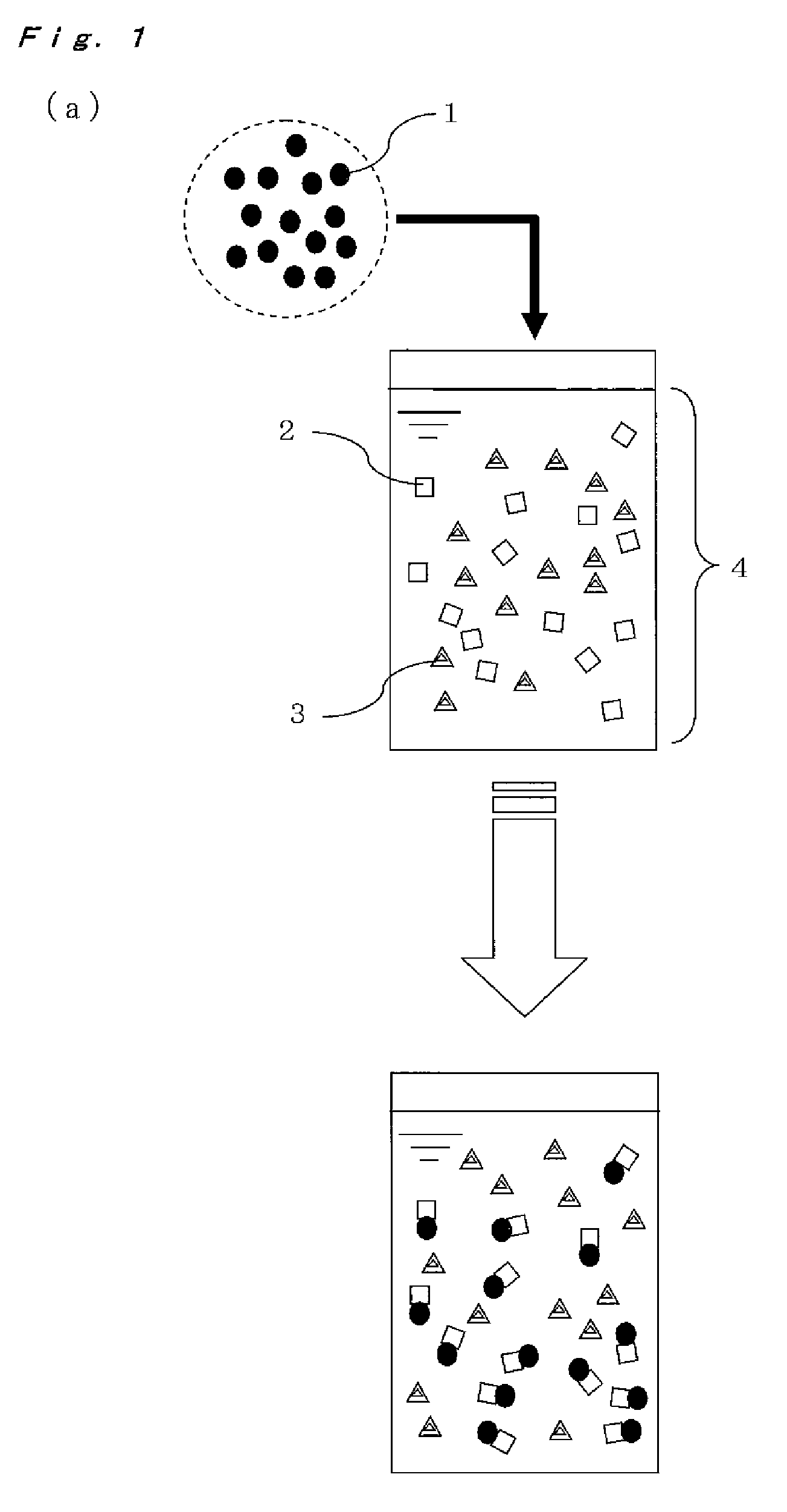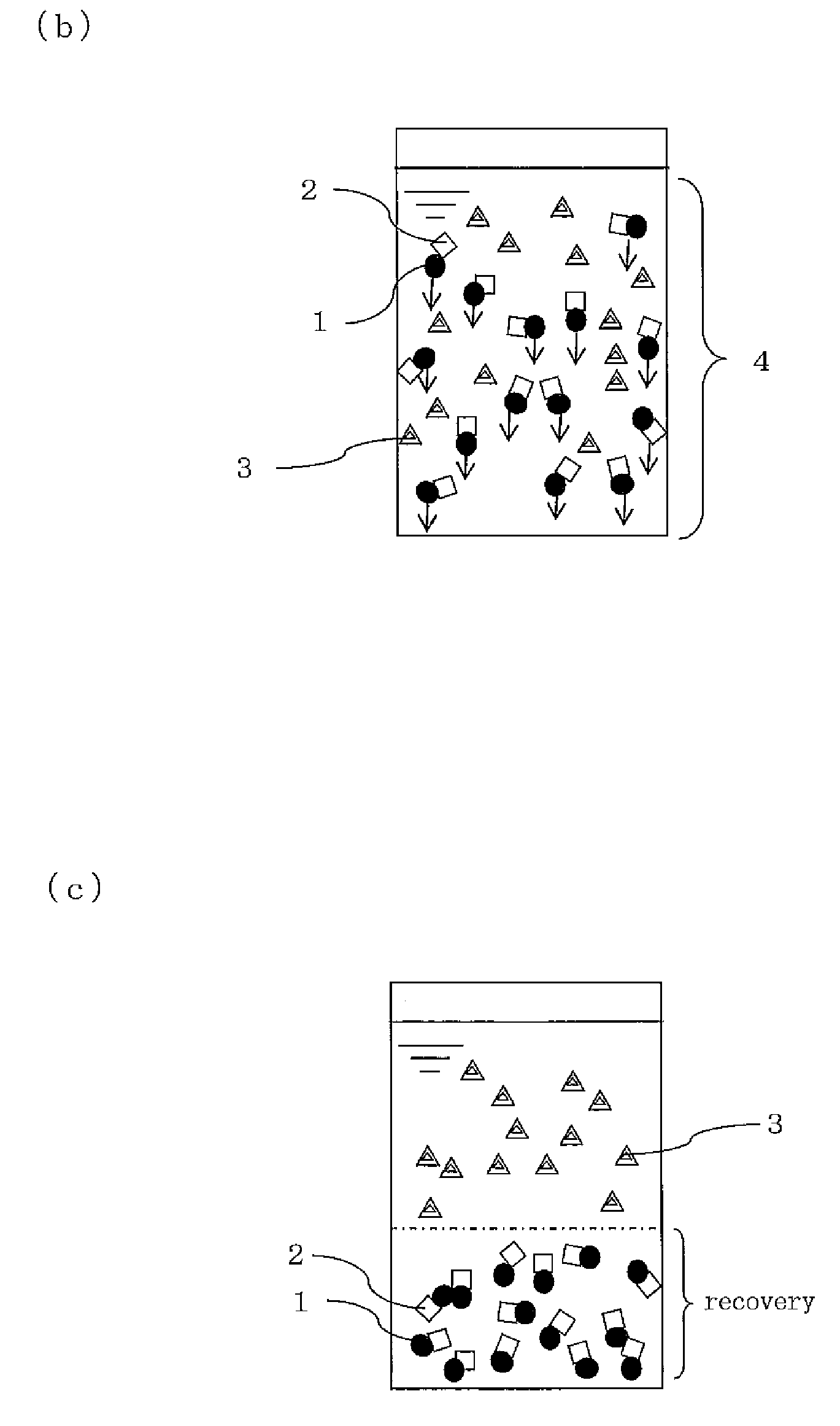Functional particle, and method for separation of target substance using the same
- Summary
- Abstract
- Description
- Claims
- Application Information
AI Technical Summary
Benefits of technology
Problems solved by technology
Method used
Image
Examples
example 1
[0140]Particles prepared in Example 1 are yttrium-doped zirconia particles P1 with a hydroxyl group immobilized thereon. First, yttrium-doped zirconia particles p1 manufactured by NIKKATO CORPORATION were prepared. The particles p1 had a particle size of 50 μm, a specific surface area of 0.02 m2 / g and a density of 6 g / cm3. 1 g of the particles p1 were dispersed into toluene and 0.5 g of 1,3,5,7-tetramethylcyclotetrasiloxane (manufactured by Shin-Etsu Chemical Co., Ltd., LS-8600) was added to the resultant dispersion. The dispersion was evaporated to remove toluene, and then the particles were allowed to stand in a vacuum desiccator at 50° C. for 4 hours. Subsequently, the particles p1 were heated in a thermostatic bath at 150° C. for 1.5 hours. It was confirmed that such a treatment made the particles p1 hydrophobic and thus a coating of 1,3,5,7-tetramethylcyclotetrasiloxane was formed on the particles p1.
[0141]Subsequently, the resultant particles were dispersed in water and then h...
example 2
[0142]Particles prepared in Example 2 are yttrium-doped zirconia particles P2 with a hydroxyl group immobilized thereon. Particles P2 are different from the particles P1 of Example 1 in that the particles P2 is magnetic particles.
[0143]First, yttrium-doped zirconia particles p2 manufactured by NIKKATO CORPORATION were prepared. The particles p2 had a particle size of 50 μm, a specific surface area of 0.02 m2 / g and a density of 6 g / cm3. 1 g of particles p2 were dispersed in water and a silane coupling agent (manufactured by Shin-Etsu Chemical Co., Ltd., KBM-903) was added to the resultant dispersion, and thereby allowing the silane coupling agent to deposit on the surface of the particles p2. Then, a Pd catalyst Catalyst-6F manufactured by SHIPLEY FAR EAST LTD. was added into the dispersion to form plating nuclei on the surface of the particles p2. The resultant particles was washed with 1.2N hydrochloric acid and a magnetic nickel plating layer was formed on the surface of the parti...
example 3
[0144]Particles prepared in Example 3 are yttrium-doped zirconia particles P3 with a hydroxyl group immobilized thereon. Particles P3 are different from the particles of Example 1 in terms of a method for preparation of particles.
[0145]First, yttrium-doped zirconia particles p3 manufactured by NIKKATO CORPORATION were prepared. The particles p3 had a particle size of 50 μm, a specific surface area of 0.02 m2 / g and a density of 6 g / cm3. 10 g of particles p3 was dispersed in 25 g of pure water and then 3 g of 3-glycidoxypropyltrimethoxysilane having an epoxy group at the end was added to the resultant dispersion, followed by stirring for 4 hours. After washing the particles with water, a dispersion obtained by supplying 10 ml of 10 wt % ethanolamine to the particles was stirred at room temperature for 12 hours. The particles were washed, filtered and then dried to obtain yttrium-doped zirconia particles P3 with a hydroxyl group immobilized on the surface. The particles P3 were hydroph...
PUM
| Property | Measurement | Unit |
|---|---|---|
| Size | aaaaa | aaaaa |
| Size | aaaaa | aaaaa |
| Density | aaaaa | aaaaa |
Abstract
Description
Claims
Application Information
 Login to View More
Login to View More - R&D
- Intellectual Property
- Life Sciences
- Materials
- Tech Scout
- Unparalleled Data Quality
- Higher Quality Content
- 60% Fewer Hallucinations
Browse by: Latest US Patents, China's latest patents, Technical Efficacy Thesaurus, Application Domain, Technology Topic, Popular Technical Reports.
© 2025 PatSnap. All rights reserved.Legal|Privacy policy|Modern Slavery Act Transparency Statement|Sitemap|About US| Contact US: help@patsnap.com



